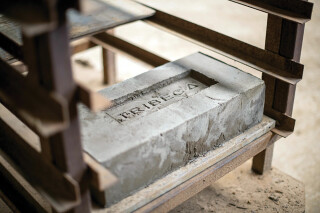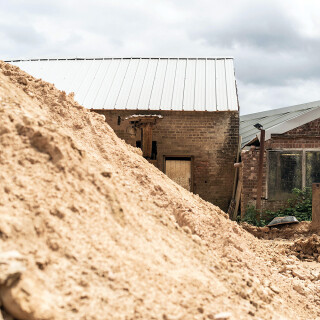Once upon a time, nearly every building was made out of the materials that were available on or near the site. Timber was from the local trees, sand, gravel and stone excavated from nearby pits and quarries. The idea that you could build like this today is almost unthinkable.
Almost, but not quite. Architect Nikolay Shahpazov, of London-based practice Bennett Associates, had long nurtured the idea of using site-won subsoil to make bricks and blocks for inclusion in one of his projects. He has finally succeeded – on a commercial development in Camden, right in the heart of London.
Before joining Bennett Associates three years ago, Shahpazov lived and worked briefly in south Devon where he became interested in the use of cob – a mixture of clay subsoil and straw – traditionally used in the south west of England.
Working with a community land trust in the Torbay area, Shahpazov proposed a sustainable development of half a dozen homes, of which several would be ‘affordable’, all built using traditional earthen methods, as well as other sustainable technologies such as grey water recycling.
An increasingly urgent desire to ‘decarbonise’ the construction industry has stimulated interest in the use of unfired earth as a building material. Earlier this year we reported on the Cobbauge project currently under way at Plymouth University, where a modified cob mixture is being developed that will meet current building regulations (TCI Magazine, January 2022).

Unfired earth does not generate the massive carbon emissions resulting from the firing of clay bricks or the burning of clinker in the production of cement and concrete. Unfiredearth is also infinitely recyclable: crush it into powder and add water and you’re back to mud again.
Shahpazov had great hopes for his Devon project, but ultimately found himself thwarted.
“It was a big disappointment,” he declares. “There was too much resistance locally and too little support from parish councils.” Shahpazov and his colleagues found that they lacked the influence of more established local builders and developers who were able to ‘schmooze’ local councillors.
Fast forward a few years and Shahpazov, now at Bennett Associates, started working with contractor VolkerFitzpatrick on the Apex building, housing offices and laboratory space on Reef Estates’ Tribeca development, north of London’s King’s Cross station.
Here, VolkerFitzpatrick will use the earth blocks to build the interior perimeter walls in the basement of the new building.
As Shahpazov discovered for himself, earth building, though ancient and traditional, is nowadays regarded by many mainstream building professionals as a bit ‘alternative’ – even anachronistic. But he says there are many good reasons why such methods should be incorporated into 21st century projects.
“When you dig out a basement you usually have to pay to get rid of the soil. But if you can reuse it on site you solve that problem and at the same time you avoid having to bring in other materials to build with,” he says.

Add to that the low carbon emissions and recyclability of the material, and earth building looks even more attractive for an environmentally-conscious builder or developer.
On the Apex project, VolkerFitzpatrick is excavating the heavy London clay to create the basement and delivering the arisings to brick-maker HG Matthews, in Bellingdon, Buckinghamshire.

Here the soil is combined with sand and straw to make unfired earth blocks for The Apex basement.
The Apex will be the first building of its scale to make use of site subsoil as a construction material, and the aim is to set a pioneering precedent for the use of earth blocks in the mainstream construction industry. In total almost 14,000 earth blocks will be laid, covering more than 90m³.
The blocks being made by HG Matthews are not actually cob (though cob blocks are available and are used to repair old cob buildings) but more specifically they are ‘rammed’ earth.
Cob can be compared to today’s 3D printing technology: it is built up in layers deposited on top of each other. Rammed earth is more like in-situ concrete: the material is packed inside formwork and consolidated to create a dense material with a smooth surface finish.

HG Matthews has been experimenting with different specifications to find the best combination of ingredients for optimum strength and durability. “We’ve looked at three types of block. The first is 100% subsoil – and that’s the weakest; then we’ve tried 75% subsoil and 25% sand, and finally 50% subsoil and 50% sand,” says Shahpazov. All mixes include some straw which improves cohesion and provides some reinforcement.
The 50/50 mixture has proved to be the strongest and HG Matthews is now carrying out final testing to refine the specification.
VolkerFitzpatrick’s senior project manager Rakesh Chavda says that thorough testing and evaluation of the earth blocks is essential, even though in this project they do not have a structural function.
“Of course there are some key construction concerns, but once we’ve overcome those there shouldn’t be any problem,” he says. The blocks will be tested to the relevant British Standards and certified as compliant with the relevant building regulations before they are used on site.
“BRE is carrying out all the fire tests and Lucideon, in Stoke-on-Trent, is conducting the tests for compressive strength,” explains Chavda.
One golden rule of earth building is that you must “keep its head and feet dry”. Water will soften and ultimately dissolve the material and, for this reason, the earth blocks used in the Apex building will sit on two courses of concrete blockwork laid on the basement slab – just to protect them in the event of flooding.
And despite the otherwise extensive use of concrete in the building’s structure, the use of earth blocks for the basement wall is still entirely justifiable, says Shahpazov:
“A lot of the time we use concrete blocks for non-loadbearing applications like this. There’s no reason to use a material that’s stronger than it needs to be when there are more suitable alternatives.”

He explains that there are other potential uses of unfired earth that could prove equally effective or better than existing materials. For example, floor screeds made of natural earth: “You can bed tiles in it and at the end of its life you could lift the floor and completely recycle it. You couldn’t do that if the tiles were bedded in a cement screed,” says Shahpazov.
The Apex building’s basement wall serves as a demonstrator for a material that Shahpazov hopes will become an industry standard. “It’s amazing that we’re able to achieve this in the middle of London,” he says. And his client – a commercial developer – took little persuading.
“It should become a standard; it’s a no-brainer. We could be so much more efficient if we put our minds to it,” says Shahpazov.
Got a story? Email news@theconstructionindex.co.uk



